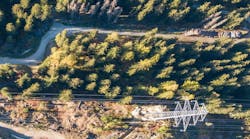Normal0falsefalsefalseEN-CAX-NONEX-NONE
The next game changer to come along was work introduced by Baltimore Gas & Electric. BG&E investigated how and what trees cause outages. This work, subsequently further investigated and detailed by ECI and John Goodfellow, dispelled the notion that a tree growing into a distribution conductor would result in an outage. It may represent a fire risk under some environmental conditions, but it is unlikely to cause an electrical fault. It was found faults are likely to occur when a branch falls on and bridges phases. This confirmed that overhangs represent an enormous risk to reliable service. It changed the prioritization of maintenance work. It made it clear that if you wish to improve reliability you need to focus on preventing trees and tree branches from falling across conductors or being able to cause a fault when they do so.
A field project undertaken by ECI and reported on by Eastern Utilities Associates established that ingrowth accounted for only 2% of tree-related outages for an on-cycle VM program and that these outages arose from growth in from the side not from the bottom. This was the first reported work to account for the total tree exposure – numbers that are staggering - and have relevance in subsequent work by this author on natural tree mortality. Other highlights of the work reported by Peter Simpson were that the vast majority of tree-related interruptions were due to tree failures, 63% of which were branch failures. It was a common observation in the industry that about half the tree-caused outages arise from danger, not hazard trees. This was the first reported work to quantify and corroborate this observation by noting that only 44% of the trees that caused an outage had a discernible fault. This is a significant finding in understanding storm damage and its possible mitigation. In major storms the number of healthy trees that fail and cause outages greatly outnumber hazard tree-caused outages. That is, the majority of the damage is caused by trees that are not targeted by the VM program.
Further understanding of tree-caused interruptions arrived through work done for National Grid Transmission and Puget Sound Energy. It proves what to utility foresters is the obvious, that the frequency of tree-related outages is correlated to the electric system’s tree exposure adjacent to the right of way.
Utility foresters are constantly trying to justify or retain funding. We discussed in the previous issue the use of tree and brush inventories combined with growth studies to determine the funding needs. Entering into a program based on these variables requires a decision regarding the number of years over which the inventory will be addressed. Given that it’s implausible to do all the work in one year, it is typically done over a period of six to 12 years, coinciding with a logical maintenance cycle based on average local growth rates. Unfortunately, over this time frame senior management support may waiver, especially if tree-related outages have dropped dramatically. What would a utility forester need to convincingly illustrate the consequences of underfunding or as it is often called, deferred maintenance? The best argument would show the impact of underfunding both in terms of tree-related outage forecasts and the cost of returning the program to the current level of reliability after some term, say 5 or 10 years of underfunding. This capability, which I would consider another major advancement, was introduced in 1996. However, it went largely unnoticed and unheralded until 2006 when it was convincingly and successfully used in a rate case (see the print copy for illustrative graphs). The impact of deferring VM work is illustrated in Vegetation Management Concepts and Principles, in general terms, and in terms of future cost and reliability expectations.
The next game changer is LiDAR. I can’t say its impact will be as great as the PC, but I think it will ultimately prove to be the biggest thing since. When we look back from the year 2030, at its influence, we may very well find it totally changed utility VM. At the present time vegetation managers are using very little of the potential LiDAR offers. It’s being used to identify potential NERC clearance violations. It has been shown that by adding an infrared scan it can be used to identify senescent trees, which may be useful not only in identifying hazard trees but also in quantifying the costs of mitigating the effects of a drought or bark beetle infestation.
The LiDAR providers are excited about the possibilities of this technology. What they envision surpasses anything I’ve heard discussed by utility vegetation managers. At least two of the LiDAR providers recognize the potential for breaking the right of way into polygons of similar vegetation types and over time to model the growth of these polygons. It will change patrols, work planning, budgeting and contracting. At this time I’m only aware of one utility that has broken down the right of way into polygons with modeled growth. Nova Scotia Power developed this without LiDAR. What was not an easy delivery for Nova Scotia Power will be simply an off-the-shelf product utilities will be able to buy from their LiDAR provider.
The public and political perception is that storm damage to electrical systems is increasing. The damages tallied by utilities shows this perception to be a fact. We need then to ask the question, why or why now? What we have largely ignored as an industry is that at one time a great deal of North America was cleared for agriculture. A substantial amount of these lands have been allowed to regrow to forests. It happens that over time the trees adjacent to the right of ways have grown much taller and may be reaching maturity. The thought may have occurred to others throughout the industry but I’m aware of only one utility that has sought to quantify how this environmental change impacts risk. LiDAR offers the potential to quantify or facilitate the quantification of the electric systems total tree exposure. Further, it will facilitate the development of growth models that will quantify the change in tree exposure and risk over time.
Even though the electric utility industry has changed considerably since the early ’90s and the introduction of competition, the culture is still predominantly risk averse. I firmly believe the LiDAR providers are on the right path but realizing their vision will require patience and persistence. In the interim they may take some comfort in the fact that the adoption of technology can be represented by a logistic curve. Sometimes the duration of the early adoption phase is longer but ultimately, if the technology has merit, the exponential expansion phase is reached.

